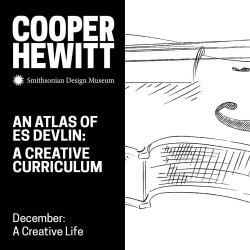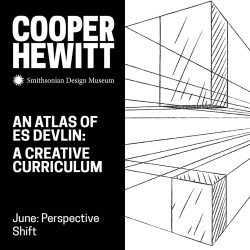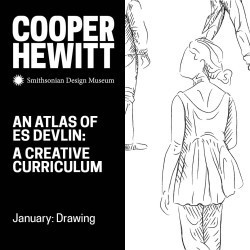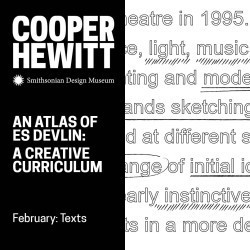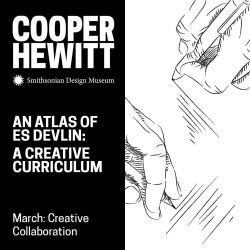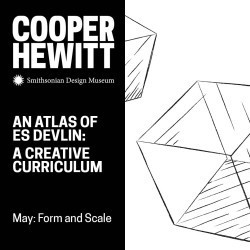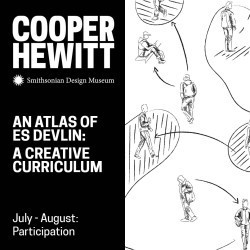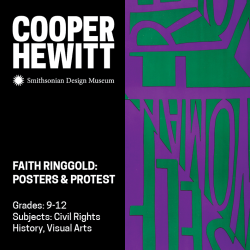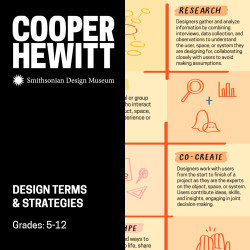Cooper Hewitt Education Department's collections
December: A Creative Life
<p><a href="https://www.cooperhewitt.org/december-a-creative-life/">DECEMBER: A CREATIVE LIFE | Cooper Hewitt, Smithsonian Design Museum</a></p>
<p>Devlin’s creative life began in childhood. Like many of us, she made things to entertain herself. She built dioramas and staged plays with her siblings, holding candy wrappers against a projector’s light in order to wash the room in different colors. She both studied and created art. An avid reader, she loved to mark in her books. She also learned to play the piano, violin, and clarinet. During visits to museums, she explored exhibitions that introduced her to new types of sculpture and installation, some of which inspired her artwork for many years to come. Over 30 years, she’s expanded and adapted her craft while nurturing a thriving studio space.</p>
<p>While Devlin models one version of an artistic life, all of us make creative choices every day. Our favorite movies, meals, books, and music reflect how we see ourselves and the world around us. Even the ways we build relationships and share experiences reflect our creativity. Connecting with our creativity sometimes requires us to change our routines in order to open new space for reflection or action. The prompts, exercises, and programs on this page provide some ways to spark and develop creative thinking.<br><br></p>
 Cooper Hewitt Education Department
Cooper Hewitt Education Department
2
June: Perspective Shift
<p><a href="https://www.cooperhewitt.org/june-perspective-shift/">JUNE: PERSPECTIVE SHIFT </a></p>
<p>Es Devlin’s public installations often transform viewers into active participants. She believes that part of her role as an artist is to create transformative experiences between audiences and artwork. Several of her sculptural installations address complex issues such as endangered species or languages. In these works, she uses visuals, sound, and performance to deepen how an audience understands and experiences a story. She hopes that these experiences shift audience perspectives and strengthen their connections to each other and to the planet. </p>
<p>In our own creative practices, shifting perspectives can open new ways into thinking about the world and how we experience it. The neighborhoods we live in might feel less familiar if we try to imagine them from the perspective of a pigeon or even a tulip in full bloom. The exercises and materials on this page invite you to explore some new perspectives to foster creative thinking. </p>
 Cooper Hewitt Education Department
Cooper Hewitt Education Department
2
January: Drawing
<p></p>
<p><a href="https://www.cooperhewitt.org/january-drawing/">JANUARY: DRAWING | Cooper Hewitt, Smithsonian Design Museum</a></p>
<p><strong>Age: Middle School, High school </strong></p>
<p>Drawing is essential to Es Devlin’s creative practice. She draws every day, making quick, rough sketches and longer, more detailed studies. Her thousands of drawings capture the seeds of imagined ideas for stage designs and sculptural installations. But drawing also helps Devlin to study and relate to the world around her. When we draw from life, our hands and eyes connect, providing a different way for us to see and understand an object, place, or person. </p>
<p>Many of us think we can’t draw or that we’re bad at it. It can be difficult to even attempt a drawing when we’re afraid of failing at it. But instead of focusing on the end product, we encourage you to explore what you might learn, experience, or feel while drawing. The process of drawing can be a kind of meditation. It can provide a rare moment to slow down and look closely. The prompts, readings, and programs on this page provide ways to explore drawing as a tool and to consider how it might support other aspects of a creative life. </p>
<p></p>
 Cooper Hewitt Education Department
Cooper Hewitt Education Department
2
May: Form & Scale
<p><a href="https://www.cooperhewitt.org/may-form-and-scale/">MAY: FORM & SCALE</a></p>
<p>Es Devlin often works with a limited vocabulary of forms. Basic shapes such as cubes, spheres, triangles, and ellipses evolve into her complex stage designs and stadium sculptures. On stage, she makes these familiar shapes behave in new ways, often transforming them through light, projection, and movement to support a story. The scale of her sculptures also changes how they appear to and effect an audience. A small cube packed with actors might seem fragile and about to break open, while a giant cube framing a pop artist might seem powerful and strong. </p>
<p>As we move through the world, we often look for and respond to forms and scale without thinking about it. We see basic shapes in the patterns of flowers or the forms of buildings, and we feel like we take up more space in a crowded elevator than we might while stretched out in an open park. The exercises and materials on this page will prompt you to think more mindfully about form and scale, allowing you to play with these basic elements as tools in your own creative practice.</p>
 Cooper Hewitt Education Department
Cooper Hewitt Education Department
2
July: Participation
<p><a href="https://www.cooperhewitt.org/july-participation/">JULY: PARTICIPATION</a></p>
<p><strong>Age: Middle School, Highschool</strong></p>
<p>In her public installations, Es Devlin often transforms audiences from viewers to participants, inviting us to become protagonists in a work. To achieve this, she might present audiences with a short film projected onto a screen that splits apart. Upon passing through the screen, we enter an unfolding narrative as a participant. Devlin might also invite audiences to navigate a mirrored maze, or she might harness the power of collective poetry, asking us to donate words to artificial intelligence algorithms that generate poems in public spaces. For Devlin, participation becomes a transformative act that deepens our encounter with an idea. </p>
<p>We engage with participation by asking our audiences to actively take part in a work. By directly engaging with a concept, we strengthen its connection with other lived experiences in our minds. Participation might also materialize in our creative practices as we become more mindful of our encounters and actions in the world around us, transforming our connections to one another and our planet. The materials on this page invite you to explore participation in your creative practice. You will find examples of what participation looks like in the work of others, as well as prompts and exercises that encourage your own participation by consciously connecting with your daily life and community. </p>
 Cooper Hewitt Education Department
Cooper Hewitt Education Department
2
Faith Ringgold: Posters & Protest
<p>Link to activity lesson: <a href="https://docs.google.com/presentation/d/1WtC8Ib_fxiRR7-CstP2CiScGIDUHF5aw5OeAZiHYd1M/edit#slide=id.p">https://docs.google.com/presen...</a></p>
<p>Analyze political posters designed by artist, author, and activist Faith Ringgold, and design your own protest poster about a civil rights issue today.</p>
<p>Grades:9-12</p>
<p>Subjects: Civil Rights History, Visual Arts</p>
 Cooper Hewitt Education Department
Cooper Hewitt Education Department
1

